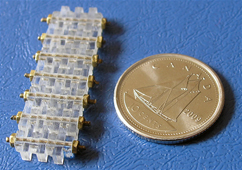Crossref Citations
This article has been cited by the following publications. This list is generated based on data provided by
Crossref.
Bekah, Sacheen
Rabiei, Reza
and
Barthelat, Francois
2011.
Structure, Scaling, and Performance of Natural Micro- and Nanocomposites.
BioNanoScience,
Vol. 1,
Issue. 1-2,
p.
53.
Humburg, Heide
Zhu, Deju
Beznia, Samia
and
Barthelat, Francois
2012.
Bio-inspired tapered fibers for composites with superior toughness.
Composites Science and Technology,
Vol. 72,
Issue. 9,
p.
1012.
Cavelier, Sacha
Barrett, Christopher J.
and
Barthelat, Francois
2012.
The Mechanical Performance of a Biomimetic Nanointerface Made of Multilayered Polyelectrolytes.
European Journal of Inorganic Chemistry,
Vol. 2012,
Issue. 32,
p.
5380.
Corni, I
Harvey, T J
Wharton, J A
Stokes, K R
Walsh, F C
and
Wood, R J K
2012.
A review of experimental techniques to produce a nacre-like structure.
Bioinspiration & Biomimetics,
Vol. 7,
Issue. 3,
p.
031001.
Chen, Po-Yu
McKittrick, Joanna
and
Meyers, Marc André
2012.
Biological materials: Functional adaptations and bioinspired designs.
Progress in Materials Science,
Vol. 57,
Issue. 8,
p.
1492.
Sun, Jiyu
and
Bhushan, Bharat
2012.
Hierarchical structure and mechanical properties of nacre: a review.
RSC Advances,
Vol. 2,
Issue. 20,
p.
7617.
Shao, Yue
Zhao, Hong-Ping
Feng, Xi-Qiao
and
Gao, Huajian
2012.
Discontinuous crack-bridging model for fracture toughness analysis of nacre.
Journal of the Mechanics and Physics of Solids,
Vol. 60,
Issue. 8,
p.
1400.
Barthelat, Francois
Dastjerdi, Ahmad Khayer
and
Rabiei, Reza
2013.
An improved failure criterion for biological and engineered staggered composites.
Journal of The Royal Society Interface,
Vol. 10,
Issue. 79,
p.
20120849.
Sullivan, Marianne
and
Prorok, Barton C.
2013.
Mechanics of Biological Systems and Materials, Volume 5.
p.
39.
Parratt, Kirsten
and
Yao, Nan
2013.
Nanostructured Biomaterials and Their Applications.
Nanomaterials,
Vol. 3,
Issue. 2,
p.
242.
Lasko, Galina
Burghard, Zaklina
Bill, Joachim
Schäfer, Immanuel
Weber, Ulrich
and
Schmauder, Siegfried
2013.
Simulation of Mechanical Properties of Bio‐Inspired TiO2/PE Nanocomposites.
Advanced Engineering Materials,
Vol. 15,
Issue. 10,
p.
908.
Li, Yaning
Ortiz, Christine
and
Boyce, Mary C.
2013.
A generalized mechanical model for suture interfaces of arbitrary geometry.
Journal of the Mechanics and Physics of Solids,
Vol. 61,
Issue. 4,
p.
1144.
Mirkhalaf, Mohammad
Zhu, Deju
and
Barthelat, Francois
2013.
Engineered Biomimicry.
p.
59.
Rabiei, Reza
Dastjerdi, Ahmad Khayer
and
Barthelat, Francois
2013.
Mechanics of Biological Systems and Materials, Volume 5.
p.
31.
Khayer Dastjerdi, Ahmad
Rabiei, Reza
and
Barthelat, Francois
2013.
The weak interfaces within tough natural composites: Experiments on three types of nacre.
Journal of the Mechanical Behavior of Biomedical Materials,
Vol. 19,
Issue. ,
p.
50.
Zhu, Deju
Humburg, Heide
and
Barthelat, Francois
2013.
Mechanics of Biological Systems and Materials, Volume 5.
p.
135.
Schäfer, I.
Lasko, G.
Do, T.A.
Pleiss, J.
Weber, U.
and
Schmauder, S.
2014.
Peptide–zinc oxide interaction: Finite element simulation using cohesive zone models based on molecular dynamics simulation.
Computational Materials Science,
Vol. 95,
Issue. ,
p.
320.
Shao, Yue
Zhao, Hong-Ping
and
Feng, Xi-Qiao
2014.
On flaw tolerance of nacre: a theoretical study.
Journal of The Royal Society Interface,
Vol. 11,
Issue. 92,
p.
20131016.
Liu, Qiang
Ma, Yongjun
Duan, Xiaohui
Zhou, Yong
Liu, Xun
and
Pei, Chonghua
2014.
Controlled crystallization of lamellar calcium carbonate crystals induced by solution of sticky rice polysaccharide (from Oryza sativa).
CrystEngComm,
Vol. 16,
Issue. 48,
p.
11042.
Chintapalli, Ravi Kiran
Mirkhalaf, Mohammad
Dastjerdi, Ahmad Khayer
and
Barthelat, Francois
2014.
Fabrication, testing and modeling of a new flexible armor inspired from natural fish scales and osteoderms.
Bioinspiration & Biomimetics,
Vol. 9,
Issue. 3,
p.
036005.
